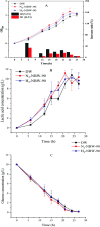Effects of nanobubble water on the growth of Lactobacillus acidophilus 1028 and its lactic acid production
- PMID: 35529350
- PMCID: PMC9072192
- DOI: 10.1039/c9ra05868k
Effects of nanobubble water on the growth of Lactobacillus acidophilus 1028 and its lactic acid production
Abstract
Nanobubble water (NBW) has been applied in various fields due to the unique properties of nanobubbles (NBs) including long-term stability, negative zeta potential and generation of free radicals. In this study, the performance of four kinds of NBW from different gases (air, N2, H2, and CO2) in addition to deionized water (DW) were investigated and compared in terms of the growth of the probiotic Lactobacillus acidophilus 1028. The NB density, size distribution, zeta potential, pH and dissolved oxygen (DO) of the NBW were firstly investigated. Results indicate that N2-NBW had the highest absolute value of zeta potential and NB density (-25.3 ± 5.43 mV and 5.73 ± 1.0 × 107 particles per mL, respectively), while the lowest was detected in CO2-NBW (-6.96 ± 2.36 mV and 3.39 ± 1.73 × 107 particles per mL, respectively). With the exception of CO2-NBW, all the other types of NBW showed promotion effects on the growth of the strain at the lag and logarithmic phases. Among them, N2-NBW demonstrated the best performance, achieving the highest increase ratio of 51.1% after 6 h cultivation. The kinetic models (Logistic and Gompertz) indicate that the culture with N2-NBW had the shortest lag phase and the maximum specific growth rate when compared to the H2-NBW and DW groups under the same cultivation conditions. Preliminary analysis on the mechanisms suggested that these effects were related to the properties (zeta potential and density) of the NBs, which might affect the transport of substances. This study suggests that NBW has the potential for promoting the production efficiency of probiotics via fermentation.
This journal is © The Royal Society of Chemistry.
Conflict of interest statement
There are no conflicts to declare
Figures



Similar articles
-
Enhanced hydrolysis of waste activated sludge for methane production via anaerobic digestion under N2-nanobubble water addition.Sci Total Environ. 2019 Nov 25;693:133524. doi: 10.1016/j.scitotenv.2019.07.330. Epub 2019 Jul 21. Sci Total Environ. 2019. PMID: 31374494
-
Enhanced energy recovery via separate hydrogen and methane production from two-stage anaerobic digestion of food waste with nanobubble water supplementation.Sci Total Environ. 2021 Mar 20;761:143234. doi: 10.1016/j.scitotenv.2020.143234. Epub 2020 Oct 26. Sci Total Environ. 2021. PMID: 33162132
-
The Effect of Nanobubble Water Containing Cordyceps Extract and Withaferin A on Free Fatty Acid-Induced Lipid Accumulation in HepG2 Cells.Nanomaterials (Basel). 2023 Aug 7;13(15):2265. doi: 10.3390/nano13152265. Nanomaterials (Basel). 2023. PMID: 37570582 Free PMC article.
-
Generation methods, stability, detection techniques, and applications of bulk nanobubbles in agro-food industries: a review and future perspective.Crit Rev Food Sci Nutr. 2023;63(28):9262-9281. doi: 10.1080/10408398.2022.2067119. Epub 2022 Apr 25. Crit Rev Food Sci Nutr. 2023. PMID: 35467989 Review.
-
Nanobubbles in water and wastewater treatment systems: Small bubbles making big difference.Water Res. 2023 Oct 15;245:120613. doi: 10.1016/j.watres.2023.120613. Epub 2023 Sep 11. Water Res. 2023. PMID: 37738940 Review.
Cited by
-
Properties of CO2 Micro-Nanobubbles and Their Significant Applications in Sustainable Development.Nanomaterials (Basel). 2025 Aug 17;15(16):1270. doi: 10.3390/nano15161270. Nanomaterials (Basel). 2025. PMID: 40863850 Free PMC article. Review.
-
Physical Properties of Ultrafine Bubbles Generated Using a Generator System.In Vivo. 2023 Nov-Dec;37(6):2555-2563. doi: 10.21873/invivo.13363. In Vivo. 2023. PMID: 37905634 Free PMC article.
-
Nanobubbles activate anaerobic growth and metabolism of Pseudomonas aeruginosa.Sci Rep. 2021 Aug 19;11(1):16858. doi: 10.1038/s41598-021-96503-4. Sci Rep. 2021. PMID: 34413439 Free PMC article.
-
Aqueous dispersions of oxygen nanobubbles for potential application in inhalation therapy.Sci Rep. 2022 Jul 21;12(1):12455. doi: 10.1038/s41598-022-16720-3. Sci Rep. 2022. PMID: 35864438 Free PMC article.
-
Effect of Nanobubble Presence on Murine Fibroblasts and Human Leukemia Cell Cultures.Langmuir. 2022 Jul 19;38(28):8575-8584. doi: 10.1021/acs.langmuir.2c00819. Epub 2022 Jul 1. Langmuir. 2022. PMID: 35776689 Free PMC article.
References
-
- Klaver F. A. M. Kingma F. Weerkamp A. H. Neth. Milk Dairy J. 1993;47:151–164.
-
- Probiotics Market by Ingredient Type (Bacteria and Yeast), by Function (Regular Use, Preventive Healthcare, and Therapeutic), by Application (Food and Beverages, Dietary Supplements, and Animal Feed), and by End-user (Human Probiotics and Animal Probiotics): Global Industry Perspective, Comprehensive Analysis and Forecast, 2018–2024, https://www.zionmarketresearch.com/report/probiotics-market, accessed 2019/06/22, 2019
LinkOut - more resources
Full Text Sources
Research Materials
Miscellaneous

